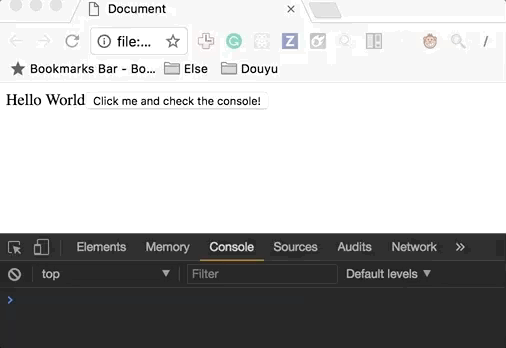概述
webpack is a module bundler for modern JavaScript applications. When webpack processes your application, it recursively builds a dependency graph that includes every module your application needs, then packages all of those modules into a small number of bundles - often only one - to be loaded by the browser.
webpack是目前最流行的用于现代JavaScript应用的模块打包器,如果你用了webpack,它会递归地构建一个你的工程所需的所有模块的依赖图,然后将所有模块打包成几个文件(通常只有一个)以供浏览器加载。
本文不打算介绍webpack的基本使用,而是着重于分析生成的打包文件的结构以及它和源文件的关系。
配置文件和待打包的源码
先来看工程结构。
1 | . |
待分析的工程的配置文件。
1 | // ./webpack.config.js |
这里只做一个最简单的功能,只有一个入口文件,./src/index.js,然后将打包后的文件是app.bundle.js。
接下来是HTML文件和JS文件。
1 | <!-- ./dist/index.html --> |
1 | // ./src/index.js |
1 | // ./src/print.js |
然后使用webpack生成打包文件。

bundle文件
现在来看看app.bundle.js文件。
1 | // ./dist/app.bundle.js |
看上去很复杂,我们先要搞清楚,整个代码的结构是怎样的,否则无从下手。
稍微整理一下会发现,其实这个bundle文件是一个大的IIFE,而这个IIFE的参数modules,实际上接收的一个由函数组成的数组,这样每个源码中的模块都是在一个函数作用域中,因此调用执行都是独立,不会相互影响,从而达到实现模块的效果。
1 | (function(modules) { |
如果把代码的结构整理成这样,就容易理解多了,各个模块函数都放到一个数组中,并在IIFE中被处理。
为了方便理解,我们把bundle文件中重要的代码逐步提取出来,再分析bundle文件到底是怎么执行的。
先从IIFE的函数体开始来看,虽然看上去里面有很多代码,但是最关键的只有两个,就是installedModeules对象和webpack_require函数,一个用于缓存已经被调用执行过的模块,另一个用于调用执行模块。
1 | (function(modules) { |
IIFE中的其他代码为webpack_require对象添加了一些辅助属性和一些支持最新ES6模块的工具方法(异步引入等)。
我们在源码中一共有两个模块(index.js和print.js),因此也就有参数数组中也就是有两个函数。
1 | (function(modules) { |
首先webpack对于每个模块的处理是分别放到一个函数中去,可以看一下webpack_require中的这一行代码:
1 | modules[moduleId].call(module.exports, module, module.exports, __webpack_require__); |
函数被传入了3个参数,分别是当前缓存模块,缓存模块的导出对象,引入对象(函数)。所以当我们需要引入某个模块的时候,就是使用第3个参数,当我们要导出对象的时候,就将其放到第2个参数中。
实际上webpack也是这么做的,当使用es的import的时候,它会被转换成使用webpack_require函数,根据模块在参数数组中的指定下标,去获取模块的导出对象。
当使用es的export的时候,导出对象会被放入webpack_exports对象中。
无论我们使用的CommonJS,还是ES的模块,webpack都会很好地处理好这些转换关系,最终导出的文件通过这种方式,实现了各个模块相隔离,并且能维护和依赖它们之间调用关系。
引入CDN文件
为了提高资源访问的速度,有时候会需要用到CDN的js资源,为了能使用CDN的资源同时又能在开发中正常使用该怎么办呢?首先肯定要在HTML中添加我们的CDN资源(注意不要在package.json中安装所需依赖,否则就不是CDN了),假如要使用jQuery的话,修改代码如下。
1 | <!-- ./dist/index.html --> |
当然,webpack的配置文件也要修改,为了能使用外置的依赖,配置文件中需要用到externals设置项。
1 | // ./webpack.config.js |
接下来,就是使用了,现在只要正常引入依赖就行了。
1 | import $ from 'jquery'; |
然后编译,再打开页面验证结果,会发现执行完全没有问题,结果跟预想的完全一样。
当然仅仅知道怎么做还不够,我们再来看看打包文件发生了什么变化。
1 | (function(modules) { |
生成的文件中多了一个模块,里面只有一句话,就是返回了一个jQuery对象,但是jQuery对象并不是我们定义的,原来jQuery通过script引入后,jQuery就是一个全局对象,这里生成的模块会直接返回这个全局对象,所以我们就能在自己的源码中直接引入并使用了。
注意jQuery这个对象被导出也是被指定的,就是刚刚在webpack的配置文件的externals中被指定的,假如我们将配置文件改为如下情况。
1 | // ... |
则生成打包文件中的源码如下:
1 | // ... |
这样做效果也是一样的。
总结
webpack中还可以引入CSS,图片等资源,如果引入这些资源的话打包文件还会生成一些内置的依赖模块(比如CSS的话,webpack配置好之后,内置模块会将其生成到HTML的head标签中)。
此外,一些额外的三方插件也会生成一些模块,,同样也是放到打包文件的IIFE的参数数组中,关于这些模块我们这里不再深入分析,感兴趣的同学可以去了解一下。
本文只对webpack的打包文件做了一个比较浅层次的分析,如果初学者看到这篇文章的话,希望能稍微加深一下对webpack生成的打包文件的理解。